Page 361 of 474
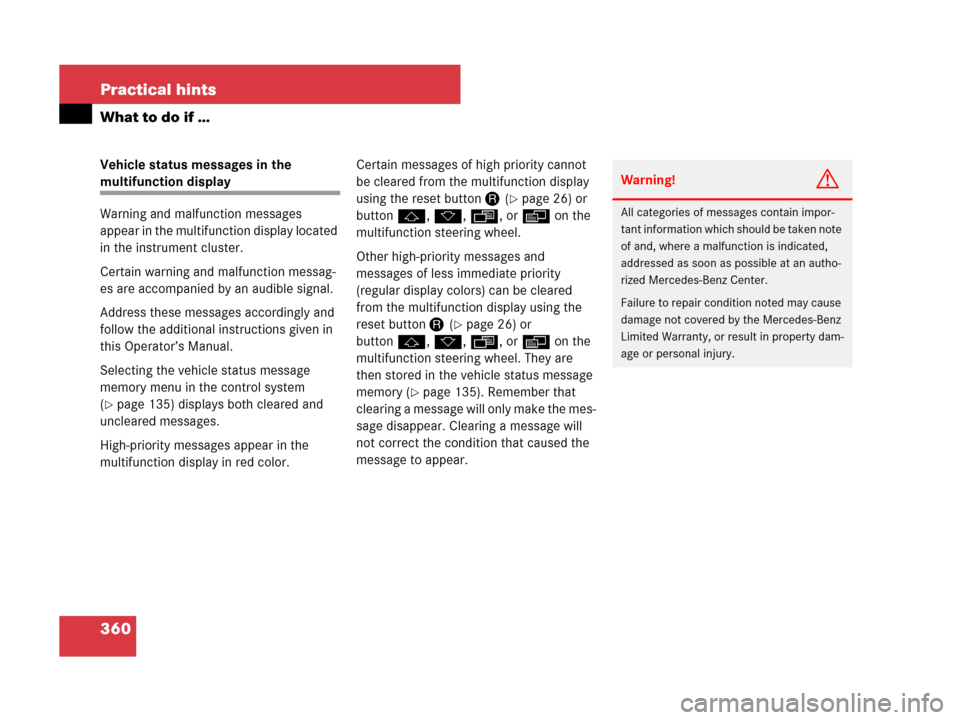
360 Practical hints
What to do if …
Vehicle status messages in the
multifunction display
Warning and malfunction messages
appear in the multifunction display located
in the instrument cluster.
Certain warning and malfunction messag-
es are accompanied by an audible signal.
Address these messages accordingly and
follow the additional instructions given in
this Operator’s Manual.
Selecting the vehicle status message
memory menu in the control system
(
�page 135) displays both cleared and
uncleared messages.
High-priority messages appear in the
multifunction display in red color.Certain messages of high priority cannot
be cleared from the multifunction display
using the reset buttonJ(
�page 26) or
buttonj, k, ·, orè on the
multifunction steering wheel.
Other high-priority messages and
messages of less immediate priority
(regular display colors) can be cleared
from the multifunction display using the
reset buttonJ(
�page 26) or
buttonj, k, ·, orè on the
multifunction steering wheel. They are
then stored in the vehicle status message
memory (
�page 135). Remember that
clearing a message will only make the mes-
sage disappear. Clearing a message will
not correct the condition that caused the
message to appear.
Warning!G
All categories of messages contain impor-
tant information which should be taken note
of and, where a malfunction is indicated,
addressed as soon as possible at an autho-
rized Mercedes-Benz Center.
Failure to repair condition noted may cause
damage not covered by the Mercedes-Benz
Limited Warranty, or result in property dam-
age or personal injury.
Page 363 of 474
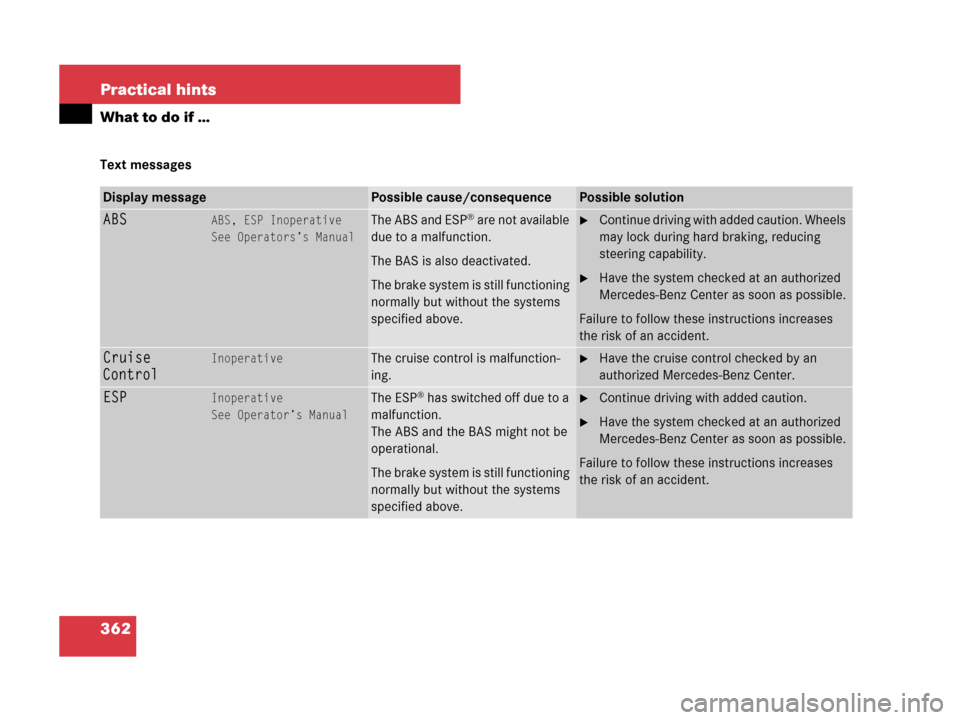
362 Practical hints
What to do if …
Text messages
Display messagePossible cause/consequencePossible solution
ABSABS, ESP Inoperative
See Operators’s ManualThe ABS and ESP® are not available
due to a malfunction.
The BAS is also deactivated.
The brake system is still functioning
normally but without the systems
specified above.�Continue driving with added caution. Wheels
may lock during hard braking, reducing
steering capability.
�Have the system checked at an authorized
Mercedes-Benz Center as soon as possible.
Failure to follow these instructions increases
the risk of an accident.
Cruise
ControlInoperativeThe cruise control is malfunction-
ing.�Have the cruise control checked by an
authorized Mercedes-Benz Center.
ESPInoperative
See Operator’s ManualThe ESP® has switched off due to a
malfunction.
The ABS and the BAS might not be
operational.
The brake system is still functioning
normally but without the systems
specified above.�Continue driving with added caution.
�Have the system checked at an authorized
Mercedes-Benz Center as soon as possible.
Failure to follow these instructions increases
the risk of an accident.
Page 370 of 474

369 Practical hints
What to do if …
Display messagePossible cause/consequencePossible solution
Check tires,
then restart
Run Flat
Indicator.There was a warning message about
a loss in tire inflation pressure and
the Run Flat Indicator* has not been
restarted yet.�Make sure that the correct tire inflation pressure is set for each tire.
�Then restart the Run Flat Indicator* (�page 316).
Run Flat Indicator
InoperativeThe Run Flat Indicator* is malfunc-
tioning.�Have the Run Flat Indicator* checked by an authorized
Mercedes-Benz Center.
Tire Pressure
Check TiresThe Run Flat Indicator* indicates that
the pressure is too low in one or more
tires.�Carefully bring the vehicle to a halt, avoiding abrupt steering and
braking maneuvers. Observe the traffic situation around you.
�Check and adjust the tire inflation pressure as required (�page 313).
�If necessary, change the wheel (�page 408).
�Restart the Run Flat Indicator* after adjusting the tire inflation pres-
sure values (
�page 313).
Warning!G
Do not drive with a flat tire. A flat tire affects
the ability to steer or brake the vehicle. You
may lose control of the vehicle. Continued
driving with a flat tire will cause excessive
heat build-up and possibly a fire.
Warning!G
Follow recommend tire inflation pressures.
Do not underinflate tires. Underinflated tires
wear excessively and/or unevenly,
adversely affect handling and fuel economy,
and are more likely to fail from being over-
heated.
Do not overinflate tires. Overinflated tires
can adversely affect handling and ride
comfort, wear unevenly, increase stopping
distance, and result in sudden deflation
(blowout) because they are more likely to
become punctured or damaged by road
debris, potholes etc.
Page 371 of 474
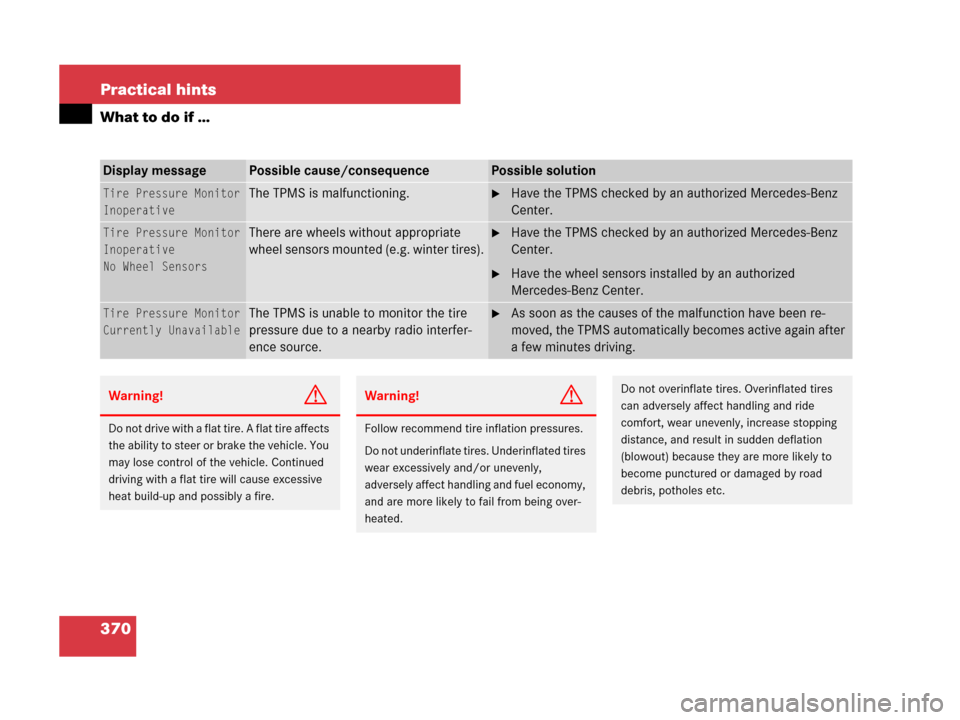
370 Practical hints
What to do if …
Display messagePossible cause/consequencePossible solution
Tire Pressure Monitor
InoperativeThe TPMS is malfunctioning.�Have the TPMS checked by an authorized Mercedes-Benz
Center.
Tire Pressure Monitor
Inoperative
No Wheel SensorsThere are wheels without appropriate
wheel sensors mounted (e.g. winter tires).�Have the TPMS checked by an authorized Mercedes-Benz
Center.
�Have the wheel sensors installed by an authorized
Mercedes-Benz Center.
Tire Pressure Monitor
Currently UnavailableThe TPMS is unable to monitor the tire
pressure due to a nearby radio interfer-
ence source.�As soon as the causes of the malfunction have been re-
moved, the TPMS automatically becomes active again after
a few minutes driving.
Warning!G
Do not drive with a flat tire. A flat tire affects
the ability to steer or brake the vehicle. You
may lose control of the vehicle. Continued
driving with a flat tire will cause excessive
heat build-up and possibly a fire.
Warning!G
Follow recommend tire inflation pressures.
Do not underinflate tires. Underinflated tires
wear excessively and/or unevenly,
adversely affect handling and fuel economy,
and are more likely to fail from being over-
heated.
Do not overinflate tires. Overinflated tires
can adversely affect handling and ride
comfort, wear unevenly, increase stopping
distance, and result in sudden deflation
(blowout) because they are more likely to
become punctured or damaged by road
debris, potholes etc.
Page 388 of 474
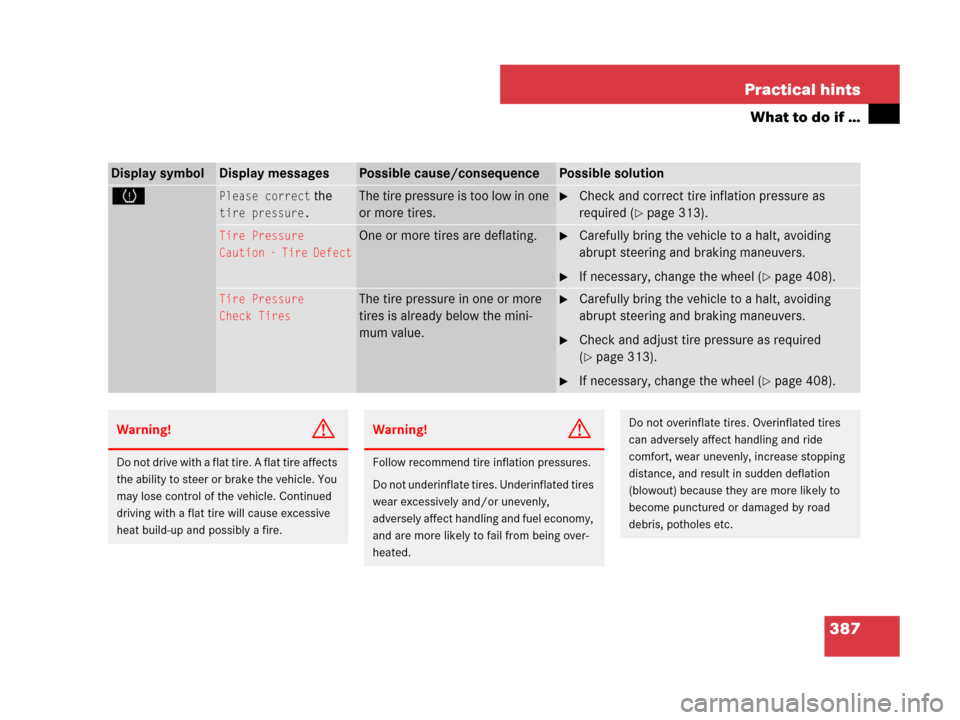
387 Practical hints
What to do if …
Display symbolDisplay messagesPossible cause/consequencePossible solution
HPlease correct the
tire pressure.
The tire pressure is too low in one
or more tires.�Check and correct tire inflation pressure as
required (
�page 313).
Tire Pressure
Caution - Tire DefectOne or more tires are deflating.�Carefully bring the vehicle to a halt, avoiding
abrupt steering and braking maneuvers.
�If necessary, change the wheel (�page 408).
Tire Pressure
Check TiresThe tire pressure in one or more
tires is already below the mini-
mum value.�Carefully bring the vehicle to a halt, avoiding
abrupt steering and braking maneuvers.
�Check and adjust tire pressure as required
(
�page 313).
�If necessary, change the wheel (�page 408).
Warning!G
Do not drive with a flat tire. A flat tire affects
the ability to steer or brake the vehicle. You
may lose control of the vehicle. Continued
driving with a flat tire will cause excessive
heat build-up and possibly a fire.
Warning!G
Follow recommend tire inflation pressures.
Do not underinflate tires. Underinflated tires
wear excessively and/or unevenly,
adversely affect handling and fuel economy,
and are more likely to fail from being over-
heated.
Do not overinflate tires. Overinflated tires
can adversely affect handling and ride
comfort, wear unevenly, increase stopping
distance, and result in sudden deflation
(blowout) because they are more likely to
become punctured or damaged by road
debris, potholes etc.
Page 389 of 474
388 Practical hints
What to do if …
Display symbolDisplay messagePossible cause/consequencePossible solution
tPHONE OFFThis display appears if buttons
ort on the multifunction steer-
ing wheel is pressed and the vehicle
is not equipped with a telephone*.
MTrunk Partition
OpenYou are trying to open or close the
retractable hardtop even though
the luggage cover in the trunk is not
closed and/or properly engaged.�Close the luggage cover (�page 241).
WTop Up
Washer FluidThe fluid level in the windshield
washer fluid reservoir has dropped
below its minimum mark.�Add washer fluid (�page 301).
Page 390 of 474
389 Practical hints
Where will I find...?
�Where will I find...?
First aid kit
The first aid kit is stored in a parcel net
behind the driver’s seat.Vehicle tool kit, vehicle jack
The vehicle tool kit is stored in a storage
compartment under the trunk floor.
The following is included:
�Collapsible wheel chock
�Vehicle jack
�Protective wrap (except SLK 55 AMG
with Performance Package)
�Alignment bolt
�Towing eye bolt
�Wheel wrench
�Valve extractor
�Electric air pump
�TIREFIT kit (SLK 55 AMG with
Performance Package only)Removing the vehicle tool kit
Vehicles with spare wheel
�Open the trunk (�page 99).
�Lift up trunk floor.
�Remove the spare wheel (�page 392).
You can now access the vehicle tool
kit.
iCheck expiration dates and contents for
completeness at least once a year and replace
missing/expired items.
��
Page 391 of 474
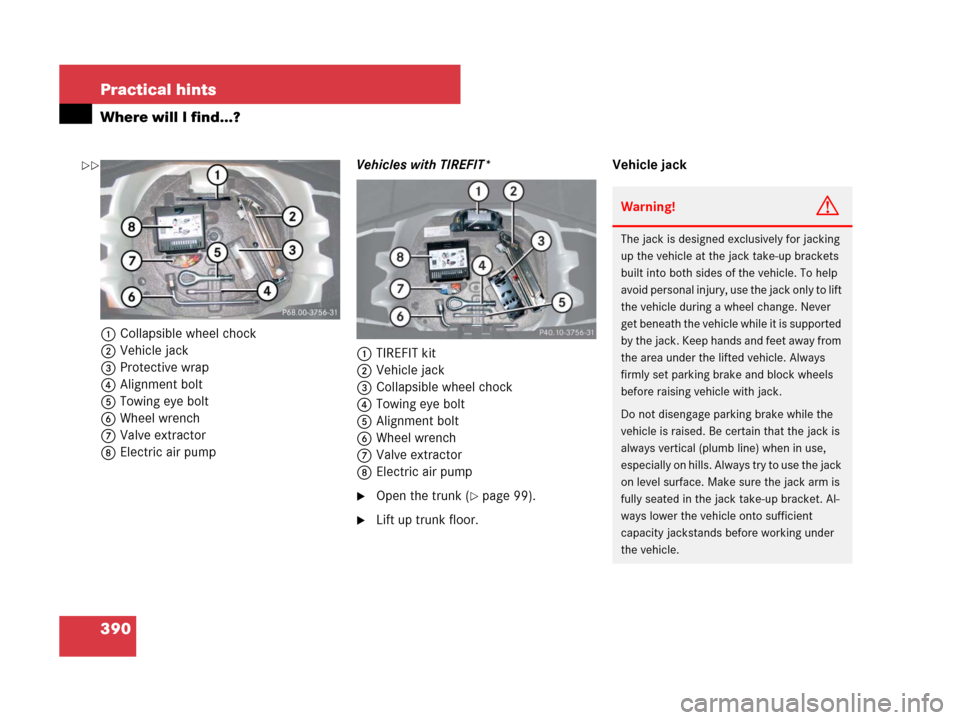
390 Practical hints
Where will I find...?
1Collapsible wheel chock
2Vehicle jack
3Protective wrap
4Alignment bolt
5Towing eye bolt
6Wheel wrench
7Valve extractor
8Electric air pumpVehicles with TIREFIT*
1TIREFIT kit
2Vehicle jack
3Collapsible wheel chock
4Towing eye bolt
5Alignment bolt
6Wheel wrench
7Valve extractor
8Electric air pump
�Open the trunk (�page 99).
�Lift up trunk floor.Vehicle jack
Warning!G
The jack is designed exclusively for jacking
up the vehicle at the jack take-up brackets
built into both sides of the vehicle. To help
avoid personal injury, use the jack only to lift
the vehicle during a wheel change. Never
get beneath the vehicle while it is supported
by the jack. Keep hands and feet away from
the area under the lifted vehicle. Always
firmly set parking brake and block wheels
before raising vehicle with jack.
Do not disengage parking brake while the
vehicle is raised. Be certain that the jack is
always vertical (plumb line) when in use,
especially on hills. Always try to use the jack
on level surface. Make sure the jack arm is
fully seated in the jack take-up bracket. Al-
ways lower the vehicle onto sufficient
capacity jackstands before working under
the vehicle.
��